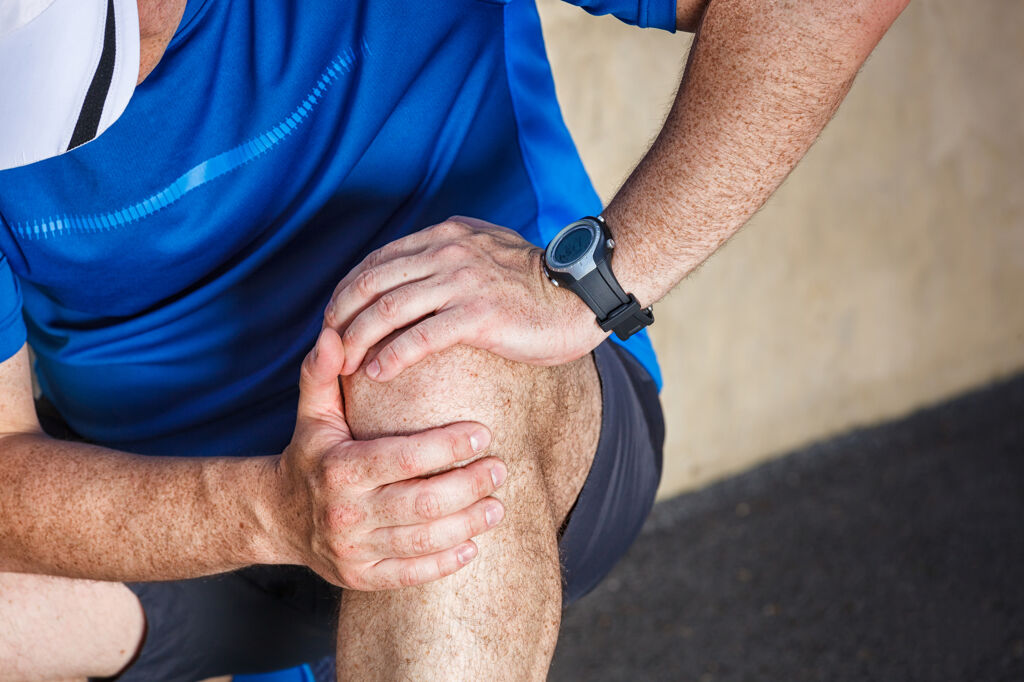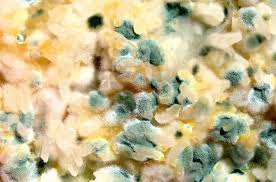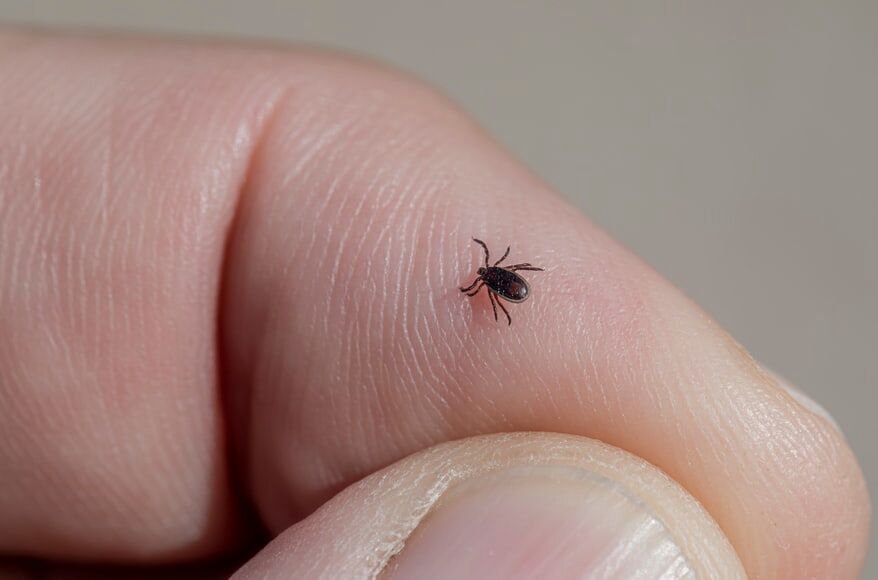Lyme Disease and Joint Pain

Can Lyme Disease Cause Joint Pain?
In this blog, we will look at Lyme Disease and joint pain. You will learn:
- How & why Lyme Disease can affect joint health
- How to address joint pain issues resulting from Lyme Disease
Do you know what Lyme Disease is and how it can affect your joint health? If you want to know more about this relatively common symptom of Lyme and how to best optimize your health, then this blog is for you. Please read on for answers!
*Please note: If you want the longer, more scientific version of this article, then please click here*
What is Lyme Disease (LD)?
Lyme Disease is a tick-borne illness. It is caused by the bacteria Borrelia burgdorferi and is transmitted through tick bites. It has many different symptoms and can present in many ways. Doctors call Lyme Disease the ‘Great Imitator’ because it has so many potential symptoms and can imitate many other diseases. It can often go misdiagnosed or undiagnosed. Even if properly diagnosed, treatment is not always effective. Because of these issues, some people suffer quite a lot from undiagnosed, misdiagnosed, untreated or improperly treated Lyme Disease. Their symptoms can simply show up as something the doctors don’t think is Lyme Disease.
We have written extensively about Lyme Disease in our blogs. Please start here with some definitions of Lyme and continue reading through our blog for tons of information on Lyme Disease. In our clinic, we are experts at diagnosing and treating Lyme.
Lyme Disease & Joint Pain
Joint issues are common in Lyme Disease and can be persistent, with joint inflammation and pain. The knee is often the joint affected by Lyme.
Lyme-related joint pain can range from mild joint inflammation that is easily treated with antibiotics to persistent and long-lasting arthritis. It is caused by the bacteria that causes Lyme Disease, which gets into the joints and causes inflammation in the tissues. Over time, this can damage the cartilage. Most cases affect only one large joint. The knee is one of the sites that the Lyme bacteria Borrelia burgdorferi likes to infiltrate (Miller JB, 2021).
What is Lyme Arthritis?
Joint pain can be the primary initial symptom of Lyme Disease or, at a later stage, it can progress to Lyme arthritis. If Lyme Disease is untreated, Lyme arthritis can develop. It can happen in cases of misdiagnosis. And may even happen after a correct diagnosis and prompt treatment. It is called post-infectious or late-stage Lyme arthritis.
We have made the point before: Lyme Disease needs to be correctly identified, diagnosed and treated early on. This is best done by a Lyme-literate doctor. In our clinic, we are Lyme-literate doctors.
If a Lyme infection is untreated, it can result in many late-stage symptoms, including arthritis. It is also possible that the arthritis persists and worsens despite antibiotic treatment (Lochhead RB, 2021).
The key problem with post-infectious Lyme arthritis is an excessive, dysregulated pro-inflammatory immune response that lasts even if the infection is treated and cleared. This can happen even after the bacterial Borrelia pathogen has been killed.
Lyme Arthritis Facts
Approximately 60% of people who go untreated for Lyme Disease develop Lyme arthritis (Donta ST, 2021).
Most patients with Lyme arthritis respond well to antibiotics, but 10–20% of patients have persistent arthritis even after treatment (Donta ST, 2021).
Lyme arthritis involves prolonged inflammation due to how the Lyme pathogen and the immune system interact (Miller JB, 2021).
Why does Lyme Disease Cause such Persistent Arthritis & Joint Issues?
The mechanisms of Lyme that can cause such severe arthritis and joint problems are not fully understood. We know that Lyme often causes an exaggerated and dysregulated immune response. Symptoms are a result of how the immune system reacts, and possibly over-reacts, to the Borrelia infection (Jutras BL, 2019).
Some degree of autoimmunity may develop and contribute to Lyme arthritis. Lyme arthritis often involves an immune cell response that can trigger an autoimmune process (Jutras BL, 2019). These unresolved inflammatory and autoimmune responses may lead to on-going arthritis, despite months of antibiotics (Donta ST, 2021). This is similar to what happens in rheumatoid arthritis, the typical autoimmune joint disease.
It has been found that there are specific highly inflammatory strains of Borrelia burgdorferi that are more likely to induce arthritis. These are found more frequently in patients who subsequently develop post-infectious Lyme arthritis (Lochhead RB, 2021).
There are genetic risk factors that can make a person more vulnerable. Prior joint trauma can also play a role in developing Lyme arthritis (Donta ST, 2021).
To Read About Blog Topic, Scroll Down
Want To Work With Our Clinic?
Do you have a chronic or mystery illness that no one has been able to help you with? Are you simply wanting to re-connect with a healthier version of yourself? It’s Time To Finally Feel Better!
But perhaps, most importantly:
Lyme arthritis can develop because the Borrelia burgdorferi bacterium has an unusual chemical composition (Jutras BL, 2019).
Borrelia burgdorferi bacteria dies during the early stages of Lyme Disease transmission (Donta ST, 2021). It is thought that Borrelia is no longer present in the synovial fluid of the joints after antibiotics. But a component of the Borrelia bacteria, called the peptidoglycan (PG), may persist and cause a continued inflammatory immune response (Lochhead RB, 2021).
A peptidoglycan is part of the cell wall, found in all bacteria including Borrelia burgdorferi. The peptidoglycan or PG forms a mesh around the cell membrane.
The Borrelia bacteria is different from other bacteria. Borrelia burgdorferi does not have a PG recycling pathway. Other bacteria do. In normal bacteria, 40–50% of their PG is degraded in the normal remodeling and recycling process (Jutras BL, 2019). In gram-negative bacteria, the majority of PG is recycled (Jutras BL, 2019).
But the peptidoglycan of Borrelia burgdorferi has a different structure and the bacteria is unable to reuse it. Instead, Borrelia dumps the PG into its immediate surroundings. So large amounts of PG fragments are released into the immediate location of the Borrelia bacteria (Donta ST, 2021).
PG then collects in the joints where Borrelia is found (Jutras BL, 2019). In fact, Lyme arthritis patients have peptidoglycan in their joint fluid (Jutras BL, 2019).
PG stimulates immune pathways and causes inflammation. PG from gram-positive bacteria can induce acute arthritis in mice and rats. In humans, PG from the Borrelia burgdorferi bacteria stimulates interleukin 1 (IL-1) to be produced (Jutras BL, 2019). This causes skin reactions characteristic of inflammation.
One study looked at patients with Lyme arthritis who did not get better with antibiotics. They found these patients still had peptidoglycan and IgG antibodies against Borrelia burgdorferi peptidoglycan in their joint fluid (Donta ST, 2021). This means the PG material remains in these patients long after the Borrelia burgdorferi bacteria has been killed (Jutras BL, 2019). PG may cause inflammation without the normal anti-inflammatory response that usually compensates for the inflammation (Jutras BL, 2019). The immune system has an inflammatory response that is specific to PG from the Borreli bacteria (Jutras BL, 2019).
Is Post-infectious Lyme Arthritis an Autoimmune Issue?
Autoimmunity is suspected. PG is elevated in the synovial tissue of post-infectious Lyme arthritis patients for months to years after antibiotics. So even after Borrelia and the infection itself has been cleared, there is still an immune response to PG and autoantigens that may contribute to autoimmunity. This may explain why people with Lyme arthritis who do not respond to antibiotics often improve with medications used in autoimmunity treatment (Donta ST, 2021).
Treatment in Conventional Medicine
In conventional medicine, treatment for long-lasting post-infectious Lyme arthritis is either drugs, or an operation, or both.
The first port of call is to try antibiotics as the standard treatment. Treatment is typically 30 days of antibiotics. If there is still a little residual joint swelling after 30 days of oral antibiotics, then 30 more days of oral antibiotics is recommended (Arvikar SL, 2015). For patients who have moderate-to-severe joint swelling after 30 days of oral antibiotics, the next step is an IV antibiotic (Arvikar SL, 2015).
A small percentage of patients may continue to have persistent arthritis for months or years after both oral and IV antibiotics (Arvikar SL, 2015), meaning the antibiotics did not work. In these cases, the standard treatment in conventional medicine is to take immunosuppressive drugs commonly used for autoimmune conditions and/or a synovectomy (Miller JB, 2021):
- Antibiotics: If antibiotics are not successful, a patient with post-infectious Lyme arthritis can try DMARDs, a category of anti-inflammatory drugs that dampen immune responses. DMARDS are used with rheumatoid arthritis, and other autoimmune conditions such as ankylosing spondylitis, psoriatic arthritis, and systemic lupus erythematosus. They decrease pain and inflammation, reduce or prevent joint damage and preserve the structure and function of the joints (Cohen S, 2022).
- Immunosuppressive drugs: Almost all patients with persistent Lyme arthritis get better when treated with immunosuppressive drugs (Donta ST, 2021). These are types of drugs used in autoimmune conditions to damp down the immune system response.
- Surgery: Synovectomy is a procedure in which the synovial tissue surrounding a joint is removed. The goal is to provide pain relief when the synovial membrane or the joint lining becomes inflamed and irritated and cannot be controlled by medication. It is used in conditions like Lyme arthritis. The knee is the joint most often selected for synovectomy as it is the joint most often affected by chronic inflammation.
How does Functional Medicine Treat Lyme-related Joint Pain and Arthritis?
While these treatment approaches may help, there are always side effects from long term pharmaceutical use and risks with surgery. In our clinic, we always look for natural treatment approaches. We use medications too but always look to less-invasive solutions with the least side effects first.
There are various things we do when treating Lyme Disease, chronic Lyme symptoms and Lyme arthritis:
- Co-infections: We test for Lyme co-infections. These possible infections need to be addressed for any Lyme treatment to be complete.
- Herbs: We use various herbs with Lyme Disease. Lyme is a complex microbe so working with and trying out different herbs gives the best chances of success.
- Supplements: It is important to cover possible nutrient deficiencies with a multi-vitamin /mineral formula. Medicinal Reishi mushrooms, Omega 3 and Monolaurin can boost the immune system and reduce inflammation.
- Anti-inflammatory diet: Inflammation can be reduced though a better diet. We like the Paleo or the gluten-free Mediterranean diet best to decrease inflammation, pain and autoimmune-type flare-ups.
- Exercise: Exercise is always beneficial but in cases of illness, it needs to be at an appropriate level. Start with physical therapy as supervision to make sure you don’t overdo it. Bike riding is very good for the knees. Being too sedentary is actually associated with immune dysfunction and toxin build-up, which are two things that can worsen Lyme symptoms.
- Stress reduction and management: We want to maintain proper hormonal balance and regulate cortisol and keep it at healthy levels. To cope with stress, we recommend meditation, yoga, tai chi, guided mediations, apps and other resources. Each person needs to find a stress management method that works best for them.
- Sleep: Good sleep is critical to maintain strong immune function and general good health.
- Gut heath: Gut health is the foundation of overall health. 70-80% of immune function is based on good gut health. At a minimum, try prebiotics and probiotics.
- Toxins: Reducing toxin exposure and possibly detoxing toxins help the immune system to function well.
In the end, healing Lyme Disease and its various symptoms is an on-going process. It is not based on one specific drug, supplement, herb or therapy. We employ a range of different immune-boosting, health-promoting strategies to strengthen the immune system and keep pathogens under control.
** Please stay tuned for our next Blog! **
As always, please get in touch with us. In our clinic, we have expertise in diagnosing and treating a range of complicated, difficult-to-diagnose conditions including Lyme Disease, post-infectious Lyme symptoms and Lyme arthritis. We can work on joint issue(s) and improve your health. Book a free health evaluation call with us today, to see how we can help you with your concerns. We can answer your questions and help you book an initial consult with one of the functional medicine doctors in our clinic.
- REFERENCES
- Arvikar SL, S. A. (2015). Diagnosis and Treatment of Lyme Arthritis. Infect Dis Clin North Am.
- Cohen S, C. A. (2022). Patient education: Disease-modifying antirheumatic drugs (DMARDs) in rheumatoid arthritis (Beyond the Basics).
- Donta ST, S. L. (2021). Report of the Pathogenesis and Pathophysiology of Lyme Disease Subcommittee of the HHS Tick Borne Disease Working Group. Front. Med.
- Iyer SS, C. G. (2012). Role of Interleukin 10 Transcriptional Regulation in Inflammation and Autoimmune Disease. Crit Rev Immunol.
- Jutras BL, L. R. (2019). Borrelia burgdorferi peptidoglycan is a persistent antigen in patients with Lyme arthritis. PNAS.
- Lochhead RB, S. K. (2021). Lyme arthritis: linking infection, inflammation and autoimmunity. nature reviews rheumatology.
- Miller JB, A. J. (2021). Stages of Lyme Arthritis. J Clin Rheumatol.
Are You Suffering From A Chronic Illness?
Does your current health situation look like this…
- Do you feel that you have tried many things and either nothing works, or the treatment does not hold?
- Have you been told that there is nothing that can be done to reverse your illness and you just need to manage symptoms?
- Does your illness impact your work, your family, your happiness and your social life?
We specialize in finding answers and solutions for complicated chronic illness when people feel like they have tried everything. If this sounds like you, book a free call with us to see if we are the right fit for your health goals.
Dr. Miles has spoken for the following organizations:

















